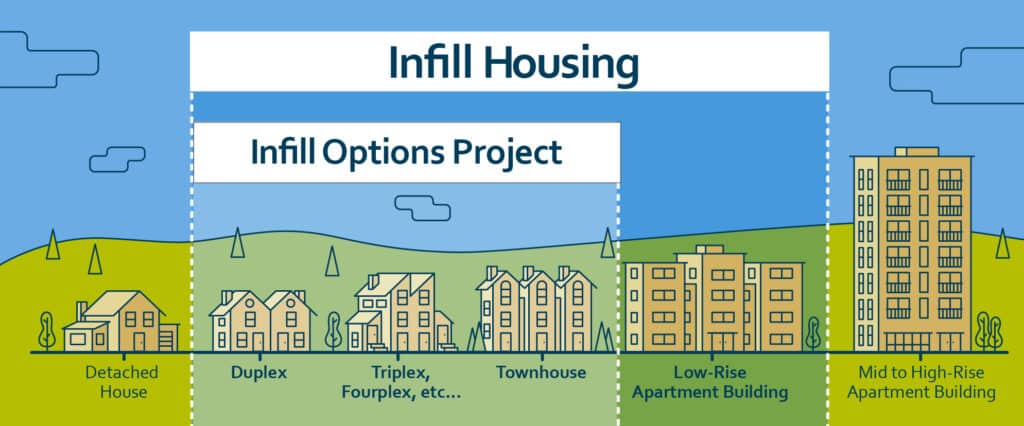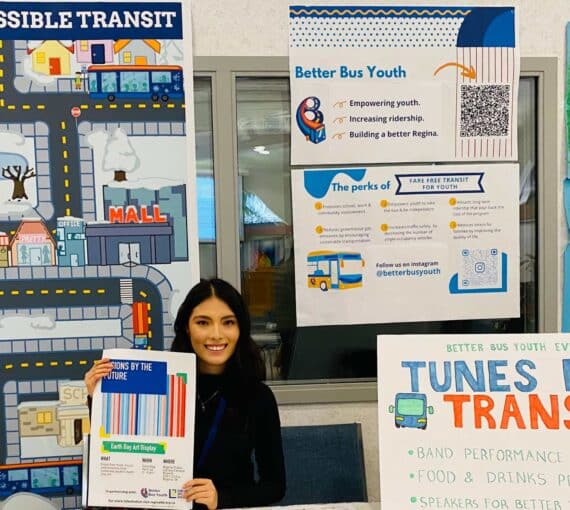
Infill zoning is key to building cities that reduce our emissions. (Photo: City of Kelowna)
In Canadian cities such as Victoria and Vancouver, infill zoning policies are meant to optimize land use by allowing multiple homes on single lots.
Infill zoning is essential for constructing cities and communities that significantly lower greenhouse emissions. With more townhouses, apartments and other housing options we can reduce transportation emissions. However, restrictive rules have put a damper on new developments and there has been pushback to increased density from owners of single-family homes who do not want other types of housing in their neighbourhoods. Political will and community engagement are needed to overcome the barriers and transform cities throughout the country.
Infill zoning is a planning policy that allows for new construction within existing urban areas, optimizing land use by filling in vacant or underutilized spaces. Cities such as Victoria and Vancouver have embraced the concept, which allows multiple homes on single lots. However, despite its promise, infill zoning is often hampered by restrictive regulations. Victoria’s new zoning laws initially allowed up to six homes on a single lot, but rules imposed on building height and parking initially stalled new developments.
Cities must be built for the generations to come, not just for those who are here today.
The political landscape
Edmonton has recently changed its zoning laws to allow for more infill housing. In an interview, Edmonton city councillor Ashley Salvador emphasized political courage in urban development. “You’re pushing back against a 70-year-old dominant planning paradigm centred around low density, auto-oriented development,” she noted. She emphasized the need for public engagement, especially from younger people. “Intergenerational inequity is an important piece to bring into this,” she added, emphasizing how “Cities must be built for the generations to come, not just for those who are here today.”
The underlying issue
The crux of the problem lies not in the concept of infill zoning but in its execution. Salvador pointed out that political challenges are a significant barrier. Inclusive public hearings and engagement sessions are crucial for bringing diverse voices to the table. Similarly, cities including Victoria and Vancouver have faced challenges in implementing infill zoning because of restrictive regulations and housing market dynamics. “It takes a lot of political courage to see where we need to go and to be willing to make the necessary changes today,” Salvador said.

Image: City of Kelowna
Inclusive public hearings and engagement sessions are crucial for bringing diverse voices to the table.
The triple bottom line
Infill zoning isn’t just about creating more homes to address the housing affordability crises; it’s a strategic approach to creating sustainable, low-carbon cities. “The connection between density and infill and our other goals around climate resilience, affordability and basic city services are all interconnected,” Salvador said.
She went on to discuss the discriminatory and exclusionary roots of zoning. “Many zoning ordinances were created to keep racialized folks out of particular neighbourhoods,” she said. “Today, zoning is still exclusionary, and folks are segregated based on income. Discrimination based on tenure is still very common.” Mixed-use development and greater housing choices offer ways way to undo discriminatory exclusionary zoning. “Allowing for mixed-use development creates the conditions for more walkable, bikeable 15-minute communities,” she said. Infill zoning also contributes to sustainable urban development by optimizing land use, reducing urban sprawl and preserving natural ecosystems.
Infill zoning optimizes land use, reduces urban sprawl and preserves natural ecosystems.
The way forward
Although infill zoning presents many challenges, it creates even more opportunities. Salvador’s insights underline the necessity for actionable plans that are implemented with precision and foresight. Cities such as Victoria, Vancouver, Edmonton and Calgary have the potential to lead the charge in sustainable development if they can effectively navigate the complexities around planning and policy-making.
Ultimately, while infill zoning charts a path to urban sustainability, its success in fostering environmentally resilient cities depends on the commitment and vision of those in positions of influence. As Salvador stated, “Political courage is necessary to make those changes.” This approach not only advances urban sustainability but also plays a critical role in mitigating climate change through strategic urban planning.
As members of your community, your voice and involvement are crucial. Advocate for infill zoning policies at local council meetings, participate in public consultations and support initiatives that prioritize sustainable urban development and more housing options. By engaging, you help ensure that our cities are not only built for today but are also prepared for a more sustainable tomorrow. Together, we can transform our urban landscapes into thriving, equitable low-carbon communities that serve future generations as well as our own.
Allowing for mixed-use development creates the conditions for more walkable, bikeable 15-minute communities.
Charged Up is the story of you — of all of us — on a mission for a cleaner, healthier charged-up Canada.


